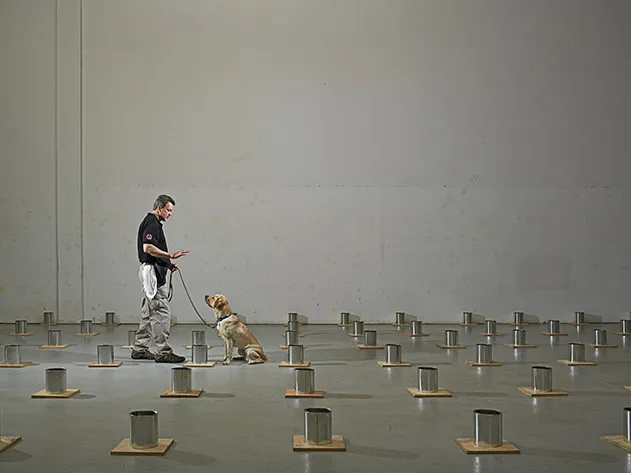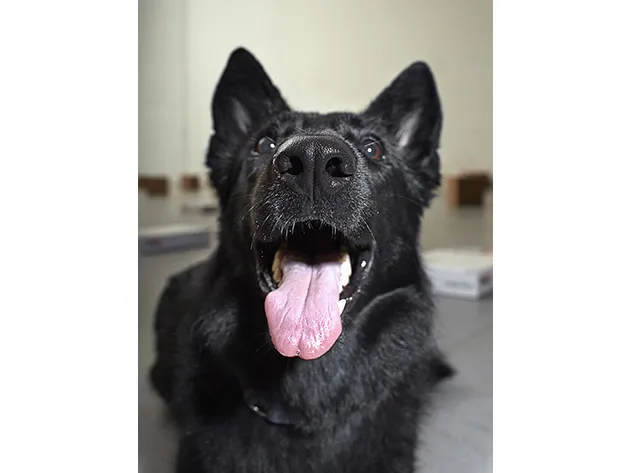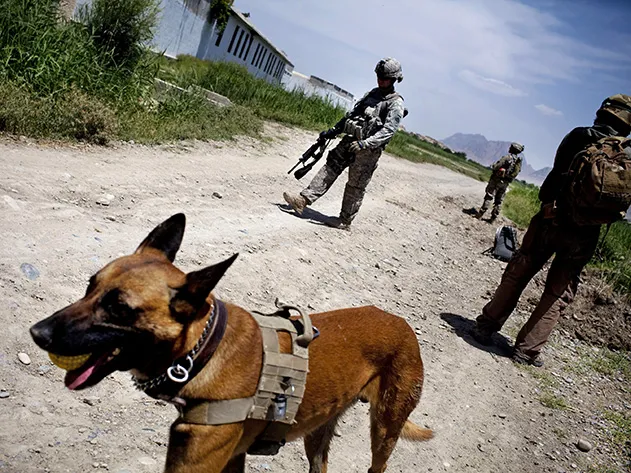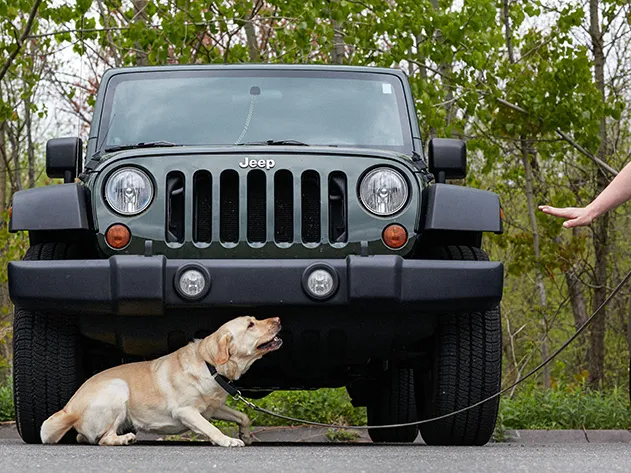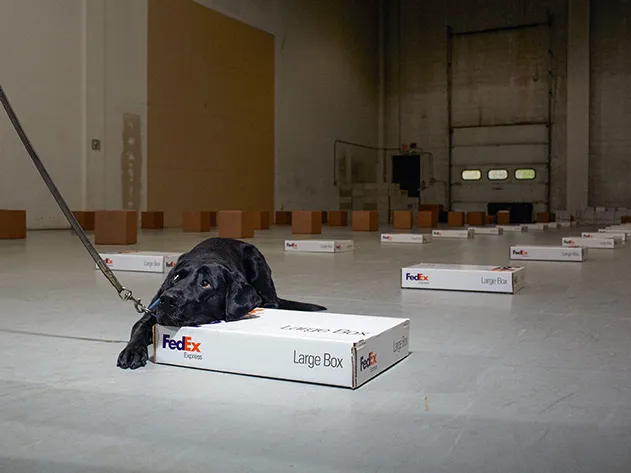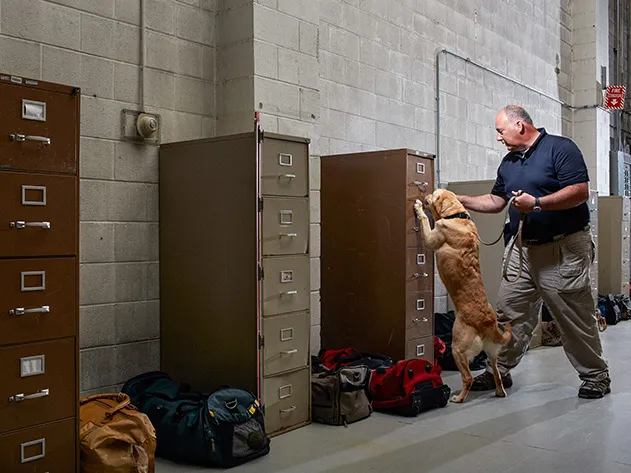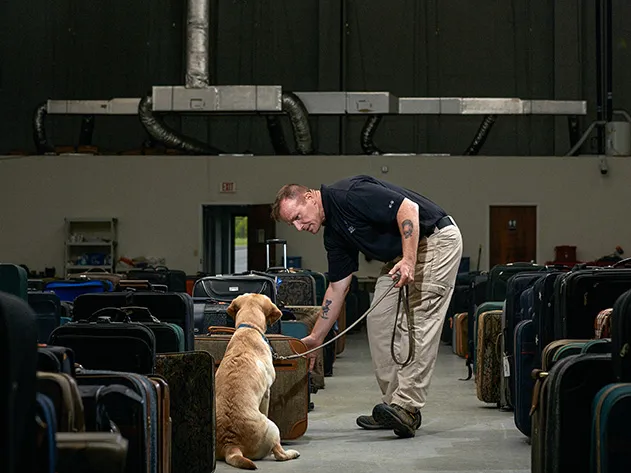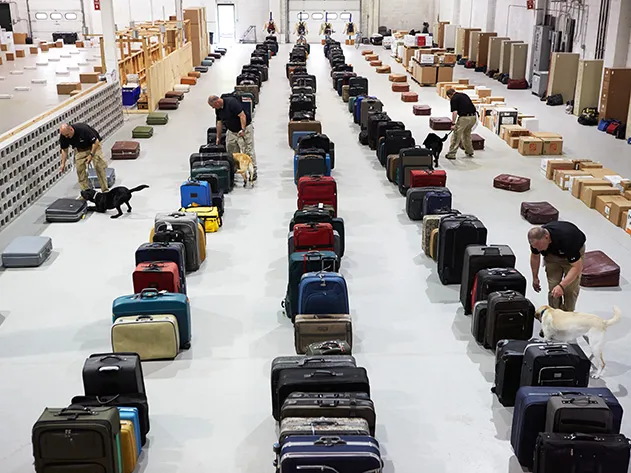The Education of a Bomb Dog
A top training academy works double time to meet skyrocketing demand for canines who can sniff out danger
/https://tf-cmsv2-smithsonianmag-media.s3.amazonaws.com/filer/Bomb-Dogs-explosive-detection-canine-training-631.jpg)
When I first meet a likable young Labrador named Merry, she is clearing her nostrils with nine or ten sharp snorts before she snuffles along a row of luggage pieces, all different makes and models. They’re lined up against the back wall of a large hangar on a country road outside Hartford, Connecticut. This is where MSA Security trains what are known in the security trade as explosive detection canines, or EDCs. Most people call them bomb dogs.
The luggage pieces joined bicycles, suitcases, shrink-wrapped pallets, car-shaped cutouts and concrete blocks on the campus of MSA’s Bomb Dog U. Dogs don’t need to be taught how to smell, of course, but they do need to be taught where to smell—along the seams of a suitcase, say, or underneath a pallet where the vapors that are heavier than air settle.
In the shrouded world of bomb dog education, MSA is one of the elite academies. It currently fields 160 teams working mostly in New York, Washington, D.C., Boston, Chicago and Dallas—the dogs always work in tandem with the same handler, usually for eight or nine years. MSA also furnishes dogs for what it will only describe as “a government agency referred to by three initials for use in Middle East conflict zones.”
Merry and Zane Roberts, MSA’s lead canine trainer, work their way along the line of luggage pieces, checking for the chemical vapors—or “volatiles”—that come off their undersides and metal frames. Strictly speaking, the dog doesn’t smell the bomb. It deconstructs an odor into its components, picking out just the culprit chemicals it has been trained to detect. Roberts likes to use the spaghetti sauce analogy. “When you walk into a kitchen where someone is cooking spaghetti sauce, your nose says aha, spaghetti sauce. A dog’s nose doesn’t say that. Instinctively, it says tomatoes, garlic, rosemary, onion, oregano.” It’s the handler who says tomato sauce, or, as it happens, bomb.
MSA’s dogs begin building their vocabulary of suspicious odors working with rows of more than 100 identical cans laid out in a grid. Ingredients from the basic chemical families of explosives—such as powders, commercial dynamite, TNT, water gel and RDX, a component of the plastic explosives C4 and Semtex—are placed in random cans. In addition, urea nitrate and hydrogen peroxide—primary components of improvised explosive devices—have joined the training regimen.
These odors are imprinted on the dog’s brain by constant repetition and reward, Pavlov-style.
Merry is working quickly and eagerly down the row of cans, wagging her tail briskly and pulling slightly on the leash. This is a bomb dog’s idea of a good time. There are perhaps five other teams working the cans along with Merry, and none of them seems remotely interested in checking out the others. Snort, snort, sniff, snort, snort, sniff, snort, snort, sniff. Suddenly Merry sits down. All bomb dogs are schooled to respond this way when they’ve found what they’re looking for. No one wants a dog pawing and scratching at something that could blow sky-high.
“Good dog,” says Roberts, the “good” a full octave higher than the “dog” in an exaggerated singsong, before reaching into a pouch on his belt for the kibble that is the working dog’s wage. It sounds pretty silly, and new trainers often have a hard time bringing themselves to talk to dogs this way. “Dogs don’t speak English,” points out Roberts, “so the only ways to communicate are gestures and tone inflection. But just try getting a six-foot ex-cop to talk baby talk—it isn’t easy. Women handlers have a much easier time with it.”
Almost all of the dogs here arrived when they were a year to a year and a half old. Before that, they all attended an unusual canine kindergarten called Puppies Behind Bars. Gloria Gilbert Stoga founded the nonprofit program in 1997 as a way to train guide dogs for the blind, but the idea was for the prison inmates to learn as much as the puppies they live with. As one inmate at the Federal Correctional Institution in Danbury, Connecticut, wrote in a training diary about her Labrador puppy, “Benjamin Franklin has shown me what really counts: love, honesty, giving and perseverance. It is sad I had to come to prison to learn this lesson.”
With the collapse of the World Trade Center in 2001, Puppies Behind Bars entered the war on terror. First, the Bureau of Alcohol, Tobacco, Firearms and Explosives, one of the country’s largest bomb dog employers, came knocking. MSA stepped up shortly after. Since then, the prison program has graduated 528 working dogs, most explosive detective canines . “Every time the ATF gets more funding they say, hey, let’s get some more dogs,” says Jan Brady, who helps run the service at the Edna Mahan Correctional Facility for Women in Clinton, New Jersey.
It would be tough to conceive of a better smelling machine than a dog. Its nose extends from the nostrils to the back of its throat, giving a dog an olfactory area 40 times greater than a human’s. Dogs have some 300 million olfactory receptor cells; humans have six million. More to the point, 35 percent of a dog’s brain is assigned to smell-related operations. A human brain assigns only 5 percent of its cellular resources to smelling, and given the low esteem in which we hold our noses, even that sounds like an overinvestment.
It’s not just a matter of quantity, either. A dog’s nasal mechanism doesn’t work the way a person’s does. For one thing, the functions of breathing and smelling aren’t all jumbled up together, the way they are for us. When air enters a dog’s nose, it splits into two separate paths—one for breathing and one for smelling. And when a dog exhales, the air going out exits through a series of slits on the sides of a dog’s nose. This means that exhaled air doesn’t perturb the dog’s ability to analyze incoming odors; in fact, the outgoing air is even thought to help new odors enter. Even better, it allows dogs to smell continuously over many breathing cycles—one Norwegian study found a hunting dog that could smell in an unbroken airstream for 40 seconds over 30 respiratory cycles.
Remember the kid in school who could wiggle his nose without touching it? Well, dogs can wiggle each nostril independently. This is not just a party trick. It helps dogs locate precisely where a particular odor is coming from, which is not a bad thing if you’re trying to find a well-hidden bomb.
In a contest for best all-around nose in the animal kingdom, however, dogs might not take top prize, says Paul Waggoner, associate director of the Canine Detection Research Institute at Auburn University. The elephant is a walking dictionary of odors. Rats and mice smell at least as well as dogs, and jackals are simply uncanny. For obvious reasons, none of these animals are serious candidates for a bomb-detection job. Where dogs ace the competition is attitude. “No other animal comes so well prepared for us to do what we need them to do,” says Waggoner. “They want to please us.”
Among dogs, the best breeds for finding bombs may be German shepherds, Belgian Malinoises (also known as Belgian shepherds) and Labrador retrievers, more for their tireless work ethic than any special olfactory prowess. Shepherds are so-called “play reward” dogs. There’s a shepherd named June training alongside Merry at MSA’s hangar. “She will work all day for her tennis ball,” says Mike Wynn, MSA’s director of canine training. Labs, perpetually hungry, are “food reward” dogs. Shepherds will accept criticism; Labs won’t—the stress of not measuring up takes the starch right out of them.
What about bloodhounds, you say? True, a bloodhound will follow a straight-line scent—an escaping convict, say —as if it’s being pulled by a string. “But they’re way down on the intelligence scale,” says Wynn, who worked with bloodhounds as a patrol dog handler with the Connecticut State Police. “Also, they stink like livestock.” Golden retrievers can outsmell everybody, but it’s tough to get them to buy into the system. “They’re so intelligent that if they don’t want to do something, they just don’t do it,” says Wynn. Some breeders are looking into Glabs—a mix of golden retriever with Labrador—to get the best of both breeds.
Bomb dogs may be the most overlooked troops in the hazy, undeclared war on terror. Until 9/11, they were mostly ignored because there were very few of them. MSA started in 1987 with a handful of dogs. By 2000, it still had only 15 teams. Then the towers fell, and from their dust rose an instant national bomb consciousness, even though it wasn’t a bomb that brought the towers down.
“After 9/11 there was just this explosion of interest in understanding the gaps in bomb detection and detection technology,” says Kenneth Furton, a research chemist who also serves as chairman of a group called SWGDOG—the Scientific Working Group on Dog and Orthogonal Detector Guidelines. “To some extent, people got interested just to show they were doing everything in their power to counter any imaginable threat. There was even a private school here in Miami that had its own private bomb dog.”
Bomb dogs are everywhere now—banks, airports, trains, post offices, sports stadiums. If bomb dogs are overlooked today, it’s because they have blended so seamlessly into the post-9/11 landscape. An explosive detection canine in an airport today doesn’t stand out anymore than a collie chasing a stick on a suburban lawn. Part of the reason people don’t notice bomb dogs is they tend to like them.
Several years ago, one Midtown Manhattan bank started using two dogs to check every package that went into and came out of the building. “People love having the dogs around—I don’t know anyone who hates dogs,” a security official at the bank says. “On the other hand, a police officer with a bulletproof vest and an M16 makes them nervous. It’s a no-brainer.”
There’s no precise figure for the number of bomb dogs working today. Furton says more than 1,000 dogs have been submitted for some kind of voluntary EDC certification—there are no mandatory national guidelines, but agencies like the Bureau of Alcohol, Tobacco, Firearms and Explosives and the Transportation Security Administration have their own standards. In all, there are more than 10,000 working dogs out there sniffing out something fishy, mostly narcotics, says Furton.
Those numbers will only climb. Each terrorist blast sends out its own bomb-dog whistle. The whistle from the recent Boston Marathon bombing was loud and particularly piercing. The Boston Police Department bomb squad did sweep parts of the course before the race, but no one holds the subsequent explosion against the dogs. The vagaries of weather and timing—it seems likely the bomb was placed after the sweep—make a sprawling outdoor event like the marathon a thankless assignment.
The Massachusetts Convention Center Authority operates the John B. Hynes Veterans Memorial Convention Center 100 yards away from where the marathon bomb went off, as well as the Boston Common Garage. The Hynes center was cordoned off as a crime scene after the bombs exploded at 2:50 p.m., and by 3:20, Robert Noonan, the authority’s chief of public safety, had called in MSA canine teams to sniff the 1,300 cars in the garage, which became a police staging area. “I expect there’s going to be a whole new look at canines,” says Noonan. “For Boston, this is a paradigm shift.”
In the days after the bombing, MSA doubled the number of its canine teams in Boston, deploying animals from as far away as Virginia to meet additional demand. “All you had to do was watch the news,” says Marc Murphy, director of MSA’s Boston operations. “The whole psyche of the city changed.”
While talking to bomb dog handlers and trainers, I kept waiting to come upon the Rin Tin Tin of EDCs, the hero dog whose intrepid snuffling saved a busload of people. It turns out there isn’t one. Well, maybe one, a German shepherd named Brandy. In March 1972, an anonymous caller threatened to blow up several TWA jets unless he received $2 million. All jets on the runway were grounded, and planes in the air turned back, among them TWA Flight 7, New York to Los Angeles. It was pure coincidence that Brandy was at John F. Kennedy International Airport. She was part of an Army-funded research project and was there to give a demonstration. Instead, she went live. Led onto Flight 7, Brandy headed straight to a briefcase labeled “crew” and filled with C4 explosive. President Richard Nixon gave the Federal Aviation Administration its own canine bomb-sniffing unit later that year.
It’s rare for a dog to find a live bomb like that, which doesn’t trouble anyone in the bomb dog business one bit. First, there’s ample evidence that these dogs are doing what they’re meant to do. Almost everyone I spoke to had stories of dogs who sat down smartly next to a police officer who, it turned out, had recently fired a handgun at a firing range or had recently handled bomb-making material.
Moreover, you don’t really want dogs finding bombs, because that means someone’s out there setting them. “It’s good to know no bombs ever got past our dogs—that’s success even if they never find a bomb,” says Michael O’Neil, MSA’s president.
Besides, a large part of a bomb dog’s mission isn’t finding bombs but deterring them. Even at $100 or more an hour, a bomb dog team is still a cheap way to keep idle threats from crippling the financial institutions that make up much of MSA’s clientele. “The cost to dump a building is insane—more millions than you could ever imagine,” says the security official of the Manhattan bank.
Where bomb dogs have really proved their mettle is on the battlefield. They find bombs on a regular basis in Iraq and Afghanistan. Before joining MSA as vice president of operations, Joe Atherall commanded Company C of the Marines 2nd Light Armored Reconnaissance Battalion in Iraq’s Al Anbar province. The unit had three dog teams attached to it.
“One day, intel directed us to a school, but we didn’t find a lot. Then we brought in the dogs,” recalls Atherall. “There were French drains around the outside of the school, and the dogs started hitting on them. When we opened them up, we found an extensive IED cache, small arms weapons and mortar rounds along with det cord and other explosive material.” Det cord is the dog whistle of odors with nearly unsmellable vapor pressure. In her book Inside of a Dog, Alexandra Horowitz, a psychologist at Barnard College, describes the sensitivity of a dog’s nose with an analogy. We might smell a teaspoon of sugar in a cup of coffee. A dog could detect a teaspoon in a million gallons of water—nearly enough to fill two Olympic-size swimming pools.
“I loved those dogs, says Atherall. “They were lifesavers.”
***
There’s something heartening about this. Counterterrorism and warfare in general have lately taken a technological turn away from boots on the ground. The air is filled with guided drones, and we’re heading fast toward the day when drones guide themselves. That no doubt helps save lives, but it has given the face of war a frightening metallic cast that unnerves people, even when the machines are on your side.
There may be nothing less like a drone than a dog. It is hard to imagine a more high-hearted warrior. Dogs work for love, they work for praise, they work for food, but mostly they work for the fun of it. “It’s all just a big game to them,” says Mike Wynn. “The best bomb dogs are the dogs that really like to play.”
This doesn’t mean that war is a lark for dogs. The daily grind of combat takes a heavy toll on four-legged grunts, too. In 2007, Army veterinarians started seeing dogs that showed signs of what they later took to calling canine post-traumatic stress disorder, for want of a more dog-centered diagnosis. Sometimes, the dogs just shut down. Other times, they became jumpy. “We’re seeing dogs that are over-responsive to sights and sounds, or that become hypervigilant—like humans that are shaken up after a car accident. It’s more about signs than science since we can’t really ask them what’s going on,” says Walter Burghardt, chief of behavioral medicine at the Daniel E. Holland Military Working Dog Hospital at Lackland Air Force Base in Texas. “Ultimately, the trained behavior of the dog can be compromised—that’s what makes this a human health concern. It can put people in harm’s way.”
Lately, the numbers for canine PTSD have been climbing, to about 50 dogs last year—between 5 percent and 10 percent of dogs on the front lines. Caught early enough, says Burghardt, half the affected dogs can be treated and returned to active duty. “The other half just have to find something else to do for a living. ”
Ideally, wouldn’t it be better if they all did something else for a living, something more wholesome like playing with kids or guiding the blind? After all, if they can replace a pilot with a computer, you’d think they could build a machine to out-smell a dog. It turns out they’ve been trying for years and they still can’t. Before it was shut down several years ago, a Defense Department project called Dog’s Nose developed an effective technology based on fluorescent polymers. That technology has been commercialized in a product called Fido X3, now owned by FLIR Systems. Some 3,500 portable Fido units have been sold, many for use in Iraq and Afghanistan.
“I don’t think we’ll ever beat a dog, because our device doesn’t have a brain,” says Aimee Rose, a sales director at FLIR Systems, which had $1.5 billion in revenue in 2012. “What we do is more complementary to dogs. Dogs are just awesome!” Out at Pacific Northwest National Laboratory, scientists are working on ionization technology to “see” vapors the way a dog does—the same basic technology used when security officers take a swipe at an airport, but far more sensitive. In the past year and a half, the technology has shown indications that it can pick up vapor levels of a few parts per trillion—sensitive enough to detect RDX, PETN, nitroglycerin and tetryl. On the other hand, says senior research scientist Robert Ewing, “Dogs have been doing this for years. I don’t know that you could ever replace them.”
